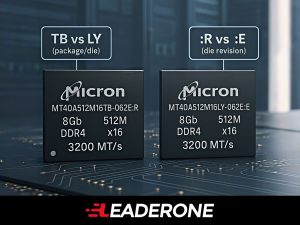
Micron MT40A512M16TB-062E:R vs MT40A512M16LY-062E:E DDR4 SDRAM chips compared with visual highlights of die revision and package type differences for enterprise and HPC memory.
The part numbers MT40A512M16TB-062E:R and MT40A512M16LY-062E:E are often encountered by engineers and procurement specialists. These are both high-performance 8Gb DDR4 SDRAM chips from Micron Technology. While they share a foundational core, the subtle differences in their suffixes indicate specific product variations. Understanding these distinctions is key to selecting the right component for enterprise servers, data centers, and high-performance computing (HPC) applications.
What MT40A512M16TB and LY Have in Common
At their core, both the MT40A512M16TB-062E:R and the MT40A512M16LY-062E:E are functionally identical in their primary specifications.
- Memory Density and Organization: Both parts are 8Gb (Gigabit) DDR4 SDRAM. The
512M16in the part number signifies their organization: 512 Megawords, with a x16 data bus width. - Speed Grade: The
-062Esuffix is consistent across both parts. For Micron’s DDR4, this indicates a data transfer rate of 3200 MT/s (MegaTransfers per second). This corresponds to a CL (CAS Latency) of 22, making them suitable for high-speed data processing. - Manufacturer: Both are products of Micron Technology, ensuring a consistent level of quality, reliability, and manufacturing standards.
MT40A512M16TB vs MT40A512M16LY: The Key Differences
The primary distinctions lie in the TB and LY prefixes and the :R and :E suffixes. While specific details are often found in Micron’s internal datasheets, these variations typically represent:
- TB vs. LY (Package/Die Characteristics): These letters most often denote a specific package type, die revision, or minor thermal and electrical characteristics. For example, one might be a newer die shrink with slightly lower power consumption, or a different package designed for a specific thermal profile. An engineer would consult the full datasheet to see if these differences affect board layout, power delivery, or thermal management in their design.
- :R vs. :E (Die Revision): The final suffix typically refers to a specific die revision. A change in die revision can indicate an update to the silicon, which might offer incremental improvements in performance, power, or bug fixes. In a comparison of MT40A512M16TB-062E:R vs MT40A512M16LY-062E:E, the difference between the ‘R’ and ‘E’ revisions is key to understanding which part is the most recent or has the most up-to-date specifications.
Why These Differences Matter to Engineers
For most general-purpose applications, both parts are fully interchangeable. However, in mission-critical or high-density designs, the subtle differences become important:
- Board Layout and Thermal Management: A slightly different package or die revision could change thermal performance.
- Power Consumption: A newer die revision might have lower power consumption, a crucial factor for large-scale data centers aiming to reduce operational costs.
- Supply Chain and Longevity: The latest die revision may have a longer product lifecycle, which is important for long-term production planning.
Conclusion
In short, while both parts are high-quality, high-speed 8Gb DDR4 SDRAM from Micron, the difference between MT40A512M16TB-062E:R vs MT40A512M16LY-062E:E is in their specific die and package characteristics. The TB vs LY and :R vs :E codes inform engineers about specific revisions and physical attributes. For a designer, these details help ensure the perfect fit for a particular application, maximizing performance, efficiency, and reliability.
Those channels can obtain:
